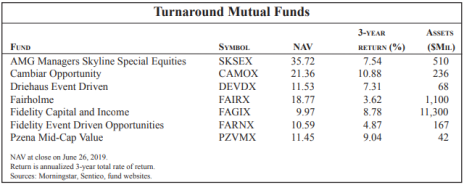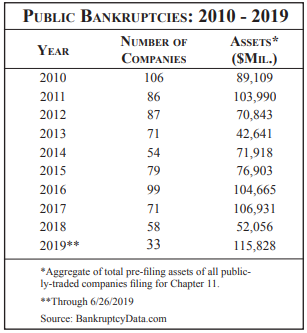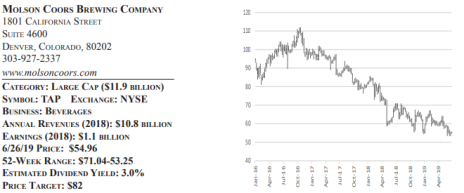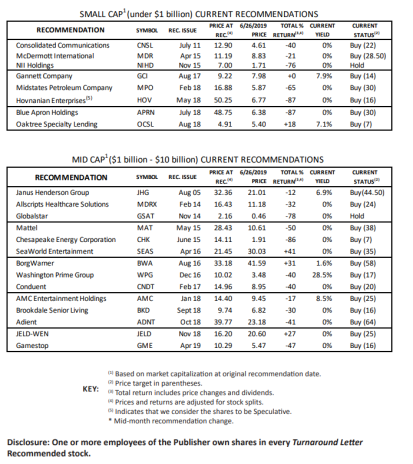Part of what makes turnaround mutual funds an inefficient and therefore profitable investing niche is that most investors avoid these securities. Managers of this small group of funds are comfortable with the contrarian approach of owning stocks that are avoided by more conventional mutual fund managers.
In this issue, we highlight seven of these turnaround-oriented mutual funds we’ve watched over the years.
Cabot Turnaround Letter 719
In This Issue:
Turnaround Mutual Funds
Bankruptcy Review
Stock Market Update
Recommendations:
Buy: Molson Coors (TAP)
Changes: CNDT, HOV
News Notes
Performance
Turnaround Mutual Funds
TURNAROUND MUTUAL FUNDS As readers know, part of what makes turnarounds an inefficient and therefore profitable investing niche is that most investors avoid these securities. A rough gauge: of the 3,202 domestic equity mutual funds, perhaps only 15-20 can reasonably be defined as focusing on turnarounds.
Managers of this small group of funds are comfortable with the contrarian approach of owning stocks that are avoided by more conventional mutual fund managers. In many cases, they look for catalysts that may return the company to favor, or they may simply buy stable companies that are highly discounted or have complicated stories. In other words, their strategies are similar to how we pick stocks here at The Turnaround Letter.
We thought it might be interesting to our readers to look at some of these turnaround-oriented mutual funds. Not only do their strategies have appeal as diversified investments, but also their websites often offer insights into their thinking and processes.
Listed below are seven funds that we’ve watched over the years. Each one has a slightly different variation on the theme, and so prospective investors will want to familiarize themselves with each prior to selecting those that most closely fit their interests. Some have had weak performance – not surprising in the late, tech-stock-driven stages of a near record-long bull market. However, when the market turns against mainstream stocks, these funds that go against the crowd can shine.
AMG Managers Skyline Special Equities (SKSEX) – This fund looks for companies that have one or more of the following characteristics: below-market average price/earnings ratios but above average earnings growth, problems that will likely reverse or special circumstances that could lead to strong appreciation potential. Turnover is a low 24%. While the fund’s long-term performance has been strong, its recent returns have lagged, partly due to its small-cap value bias which itself is out of favor.
Cambiar Opportunity Fund (CAMOX) – Part of the $11 billion Cambiar Investors group, this fund is similar to the company’s original Large Cap Value strategy that looks for catalysts and changes (Cambiar is Spanish for “change”) that will create an inflection point to drive the shares higher. The fund holds a concentrated roster of 35-45 stocks and has been managed by veteran value investor Brian Barish since 1997.
Driehaus Event Driven Fund (DEVDX) – This aggressive fund is managed like a hedge fund, with a concentrated portfolio of 25-50 positions, a high 1.90% fee ratio, a sizeable number of short-sale positions and a rapid 101% turnover rate. It has earned a four-star rating from Morningstar. The fund emphasizes special situations companies involved in mergers, spin-offs, restructurings and complex business models. It also invests in risk arbitrage and other opportunities. About a third of its assets are fixed income, and nearly three-quarters of its positions are in the financial and healthcare sectors. While small in size, it is backed by the $7.6 billion in assets Driehaus Capital Management, which was founded in 1982.
The Fairholme Fund (FAIRX) – Although performance has severely lagged the S&P500 over the past three years, the fund is having a very strong 2019, led by its large positions in St. Joe Paper and preferred shares of Fannie Mae and Freddie Mac. Its manager, the respected Bruce Berkowitz, is comfortable with well-out-of-consensus positions and staying with them, indicated by the low 16% turnover ratio.
Fidelity Capital and Income Fund (FAGIX) – This high-yield bond fund emphasizes distressed bonds while also holding about 21% of its assets in equities. Among its peers, it has one of the strongest track records, earning it five stars from Morningstar. The portfolio manager, Mark Notkin, has overseen the fund since 2003. When troubled times arrive again, this fund is likely to find a way to capitalize on the opportunities.
Fidelity Event Driven Opportunities (FARNX) – Launched in late 2013, this fund focuses on companies involved in events such as reorganizations, changes in strategy or management and other corporate actions. Its current roster of 55 holdings leans toward small and midcap companies with a bias toward tech and consumer discretionary stocks. High turnover (89%) and high fees (1.12%), however, probably contribute to its lackluster performance.
Pzena MidCap Value (PZVMX) – Overseen by veteran value investor Richard Pzena, investors can participate in a strategy that invests in undervalued companies with temporary problems. The fund holds sizeable positions in Turnaround Letter recommended Jeld-Wen Holdings and Newell Brands. Its current roster is concentrated (only 42 names) and turnover is low (34%). While the MidCap Value mutual fund is small, it is supported by Pzena’s team of 25 research analysts that oversee a total of $35 billion in assets. Readers may also want to check out Pzena’s website as the company is publicly traded and full of interesting market commentary.
Mid Year bankruptcy Review and Outlook
Bankruptcy activity has picked up modestly, in terms of the number of publicly traded companies filing for Chapter 11, in the first half of 2019 compared to 2018. There have been 33 public companies entering bankruptcy so far this year compared to 29 at this time last year. However, when you look at the total assets of public companies going into bankruptcy, the numbers are up dramatically. In fact, more assets went into bankruptcy in the first half of this year – almost $116 billion – than in any full year since 2010. (See the table above.)
This 2019 asset total is skewed by the huge bankruptcy filing by PG&E, the massive California utility, which had $71 billion in assets. But even if you completely ignore PG&E, the mid-year asset total was higher in 2019 than in 2018. Moreover, nine companies with more than a billion dollars in assets filed for bankruptcy in 2019 compared to seven at this time a year ago.
Interestingly, seven of the companies that have filed for Chapter 11 in 2019 are entering bankruptcy for the second time – so-called “Chapter 22s.” Six of them were public both times they filed, and one, Gymboree, was public the first time around and private the second. Energy bankruptcies remained prominent in 2019, with seven of the 15 largest filers involved in the oil & gas industry, plus a large coal producer. No other sector had an outsized presence on the list of the largest Chapter 11s. Somewhat surprisingly, only one of the 15 largest public bankruptcies this year was even remotely related to retailing – FTD, the floral delivery company. But the list of private bankruptcies remains littered with retailers.
From an investment perspective, PG&E is the most interesting name on the list at this time. The utility’s bonds never fell very far after the bankruptcy was announced, and so their gain potential is relatively modest. Most of the post-filing volatility has been in the company’s stock, which dipped as low as about 7 in January and currently trades around 21.
Unlike most stocks of companies in Chapter 11, the PG&E stock is likely to have some real value, and it could rise considerably from here. The problem is that the stock is difficult to analyze because its ultimate value is largely in the hands of the courts and California politicians.
We expect bankruptcy activity to continue to pick up as more of the huge amount of lower quality debt that has been raised since 2009 comes due. Even if the economy stays strong and the debt markets remain placid, a reasonably large amount of that debt will default or require restructuring. Any weakness in the economy or hiccups in the debt markets could boost the number of defaults and restructurings considerably.
MID-YEAR STOCK MARKET UPDATE: MORE SURPRISES AHEAD?
In our outlook last December, we expected that the S&P500 would return about 7% in 2019, yet with a wide range of potential outcomes. So far, the market has clearly veered to the high side of this range, with the S&P500 returning a remarkably strong 18% in the first six months and eclipsing its former record high. Smallcap stocks have fared nearly as well (+16%), although value stocks (+16%) have lagged growth stocks (+22%). Year-to-date returns in developed countries (+11%) and emerging markets (+9) seem pale only by comparison to the surging U.S. markets.
However, as sports enthusiast would agree, the second half of any season can look very different from the first half. From here, we continue to believe the range of possible full-year returns is wide. Continued economic strength, ever-easier monetary policy, positive but moderated earnings growth (consensus is for +3% growth), and relief from the trade war could produce another surge in returns. However, money-losing IPOs with valuations that can best be measured by an altimeter, paired with credit spreads that can best be observed with a microscope, indicate a fairly high degree of investor confidence that might quickly fade if we see a slowing economy, rising trade wars or burgeoning corporate and government debts.
We don’t see an imminent recession in the United States, as economic strength remains robust and widespread. While parts of the yield curve are inverted, which in the post-war period has often signaled an approaching recession, the curve has lost much of its predictive ability due to fundamental changes in the economy and in central bank policy. We also see little inflation risk as there are “too many goods chasing too little demand,” an inversion of prior periods of global inflation.
So, while we are holding to our view that the S&P 500 will produce a 7% full-year return, we accept that we could be wildly wrong. We remind investors of one of our most basic investing beliefs: you should not try to time the markets. Rather, you should keep as much money in stocks as you are comfortable with and stay the course. If you try to time the market, you risk bailing out just before the market rebounds and then returning just before it peaks.
After all, who would have predicted in January that the St Louis Blues, then ranking as the NHL’s worst team, would win the Stanley Cup only five months later?
Purchase Recommendation: Molson Coors Brewing Company
Background: Molson Coors Brewing Company is one of the world’s largest beer companies, producing the highly-recognized Coors, Molson, Miller and Blue Moon brands as well as numerous local, craft and specialty beers. About two-thirds of its revenues come from the United States, where it holds a 24% share of the beer market. Canada-based Molson (founded in 1786) and Colorado-based Coors (founded in 1873) combined in a 2005 merger of equals. In 2008, the company received a 42% stake in the MillerCoors joint venture, which was created to hold the U.S. operations of SABMiller and Molson Coors. Molson Coors acquired the remaining 58% interest, plus Miller’s international operations, for $12 billion in 2016, unifying all of the brands’ global operations under one roof.
Enthusiasm for its post-consolidation prospects drove TAP shares to over $110 in October 2016, with some analysts estimating the shares could reach $120 or more. Supporting the stock was a modestly favorable revenue outlook, along with substantial opportunities to reduce redundant costs and inefficiencies, and $2.4 billion in tax benefits. However, since then, the share price has been cut in half. Investors looking for revenue growth (which is to say, most investors) have fled as Molson Coors’ beer volumes have been declining. Combined with increases to its cost of goods sold, and worries that the company’s marketing spending will need to increase, the concern is that Molson Coors will be unable to maintain its EBITDA margins and cash flows. The company’s elevated debt balance further weighs on its shares.
Analysis: Investors’ doubts about Molson Coors’ growth have created a bargain share price. The current EV/EBITDA multiple of 9.3x is nearly 30% below its peer average. Its 11.9x price/earnings multiple is even more of a bargain. TAP shares discount a lot of bad news.
Despite the worries, Molson Coors’ revenues have staying power. While volumes remain soft, the company has successfully raised prices, with a surprisingly strong +3.7% boost last quarter. In addition, some of the recent revenue weakness has been due to the strong U.S. dollar – a trend which likely cannot continue forever. The positive start to the year, with net sales increasing 0.6%, plus favorable commentary from management, provides some encouraging evidence of the company’s ability to maintain its revenues.
Further, Molson Coors continues to invest in growth initiatives. Not only is it actively supporting its existing brands with marketing spending, it is also building new brands and expanding its geographic reach into Latin America, Africa and the Asia Pacific region.
Perhaps more important to value investors, the company is firmly focused on increasing its profits and cash flow. It is currently wrapping up $700 million in cost-cuts over the past three years, exceeding management’s initial estimates, and it recently announced another $450 million in cuts over the next three years, equal to about 4.2% of revenues. This provides considerable funds to re-invest into growth initiatives and to help offset the rising input costs while still producing bottom line benefits. Additionally, an incremental $100 million in cash should be freed-up from more efficient use of its working capital. Molson Coors reiterated its guidance for full-year 2019 underlying free cash flow of $1.4 billion, stable with last year.
The company’s generous cash flow, equal to about 12% of its equity value, should allow them to pare their debt to their targeted 3.75x EBITDA level by mid-year. Once reached, the management has essentially promised a dividend increase of as much as 30% later this year, providing a potential 4% yield at the current share price. Even after the higher dividend payouts, Molson Coors would produce over $700 million a year in surplus cash flow.
While progress toward stability may not satisfy the market’s quarter-by-quarter expectations, and the shares may continue to languish for a time, we see considerable value for patient investors. Good things tend to happen to cheap stocks of stable companies with lots of free cash flow.
We recommend the PURCHASE of shares of Molson Coors Brewing Company (TAP) with an $82 price target.
Other Ratings Changes
CNDT – Following the sharp sell-off after the weak first quarter earnings report, Carl Icahn raised his stake to 15% and the company hired a new president/chief operating officer. We return Conduent shares to a Buy with a $20 price target.
HOV – Hovnanian’s second quarter results indicate progress toward a recovery. However, given the heightened risk from its heavy debt load and the slow path toward higher profits and cash flow, we are reducing our price target to $16 and now consider HOV shares to be Speculative.
NEWS NOTES:
Washington Prime Group is a mall-focused real estate investment trust (REIT) working aggressively to improve its long-term prospects. While we believe their turnaround will ultimately be successful, their surplus cash flow is shrinking, significantly increasing the chances that they sharply reduce their dividends later this year.
With Blue Apron’s 1:15 reverse split on June 17th, we adjusted the price target to $30.
McDermott’s fundamentals are looking up, as the management appears to have fully scoped the losses on its legacy CB&I contracts, and its order book is strengthening. With the shares still near long-time lows, we think MDR stock looks poised to rebound from here.
Performance
The tables below and on the next page show the performance of all of our currently active recommendations, plus recently closed out recommendations.







